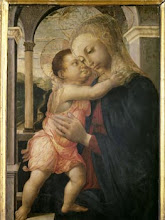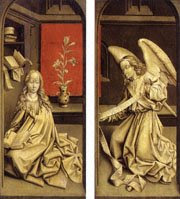
giovedì
:: Sandro Botticelli...

Summary of works by Botticelli
early religious page 1 page 2 late
Cappella Sistina San Barnaba San Marco
allegories Nastagio scenic stories portraits
drawings illustrations for Dante's Divine Comedy

BOTTICELLI, Sandro
(b. 1445, Florence, d. 1510, Florence)
Biography
Florentine painter (original name Alessandro di Mariano Filipepi), neglected for centuries but now probably the best-loved painter of the quattrocento. The name 'Botticelli', meaning 'little barrel', was originally given to an older brother, presumably because he was portly, but it became adopted as the family name.
Sandro trained with Filippo Lippi, who was the most important influence on his style. By temperament he belonged to the current of late 15th-century art which reacted against the scientific naturalism of Masaccio and his followers and revived certain elements of the Gothic style - a delicate sentiment, sometimes bordering on sentimentality, a feminine grace, and an emphasis on the ornamental and evocative capabilities of line. Almost all Botticelli's life was spent in Florence, his only significant journey from the city being in 1481-82, when he worked on the decoration of the Sistine Chapel in the Vatican, where he painted side by side with Perugino, Rosselli, and Ghirlandaio. The fact that he was called to Rome for such a prestigious commission shows that he must have had a considerable reputation, and by this time the most characteristic idiosyncrasies of his style had already gained shape in the celebrated poetic allegory known since Vasari as the Primavera (Uffizi, Florence, c. 1478). There is evidence that the patron who commissioned this and two of his other famous mythological paintings (The Birth of Venus and Pallas and the Centaur, both in the Uffizi) was Lorenzo di Pierfrancesco de Medici (second cousin of Lorenzo the Magnificent), a wealthy Florentine with strong interests in Platonic philosophy. It has been suggested that it was this philosophy that prompted the new idea of large-scale pictures with a secular content; the classical deities represented are not the carefree Olympians of Ovid's tales but the symbolic embodiment of some deep moral or metaphysical truth. Given that the Neo-Platonists regarded Beauty as the visible token of the Divine, there would be no blasphemy in using the same facial type and expression for Venus and for the Holy Virgin.
According to Vasari, Botticelli later fell under the sway of Savonarola's sermons, repented of his 'pagan' pictures, and gave up painting. The final part of this statement is definitely incorrect and the rest is doubtful, but it is certainly true that Botticelli's later paintings (e.g. the Lamentation in the Alte Pinakothek, Munich, and the Mystic Crucifixion in the Fogg Art Museum, Cambridge, Massachusetts) are more obviously 'serious' - solemn, intense, sometimes ecstatic - than his early work. The most telling example is the Mystic Nativity (National Gallery, London, 1500), which bears a cryptic inscription seeming to imply that Botticelli expected the end of the world and the dawn of the millennium.
Botticelli ran a busy studio (his most important pupil was Filippino Lippi) and his surviving output is large for a painter of his period. Apart from religious and mythological pictures, he produced some memorable portraits and also some marvelously delicate drawings - mainly in pen outline - for a lavish manuscript of Dante's Divine Comedy (now divided between the Staatsbibliothek, Berlin, and the Vatican Library). Although little is known of his life, it seems clear that at the peak of his career he was the most popular painter in Florence. His patrons included some of the city's finest churches and most distinguished families, and several of his paintings (particularly those on the theme of the Virgin and Child) exist in several versions or copies, attesting to the vogue they enjoyed. He worked for the great families of Florence, especially the Medici family, for whom he painted portraits, most notably the Giuliano de' Medici (1475-1476, National Gallery of Art, Washington). The Adoration of the Magi (1476-1477, Uffizi, Florence) was painted on commission (though not for the Medicis), and contains likenesses of the Medici family as well as a likeness of himself.
Botticelli also painted religious subjects, especially panels of the Madonna, such as the Madonna of the Magnificat (1480s), Madonna of the Pomegranate (1480s), and Coronation of the Virgin (1490), all in the Uffizi, and Madonna and Child with Two Saints (1485, Staatliche Museen, Berlin). Other religious works include Saint Sebastian (1473-1474, Staatliche Museen) and a fresco, Saint Augustine (1480, Church of the Ognissanti, Florence). In 1481 Botticelli was one of several artists chosen to go to Rome to decorate the walls of the Sistine Chapel in the Vatican. There he executed The Youth of Moses, the Punishment of the Sons of Corah, and the Temptation of Christ.
After Leonardo's return to the city in 1500, however, Botticelli's linear style must have looked archaic and he died in obscurity. His fame was not resurrected until the second half of the 19th century, when the Pre-Raphaelites imitated his wan, elongated types, Ruskin sang his praises, and Walter Pater dedicated to his art one of his most eloquent essays. At the end of the century his work was a major influence on Art Nouveau.
:: Antoniazzo Romano...






ANTONIAZZO ROMANO
(c. 1430-1508/12)
Biography
Antoniazzo Romano (Antonio Aquilio) was a pupil of Benozzo Gozzoli, mainly active in Rome. He was a painter from the Colonna rione (quarter) of Rome who worked in the city for more than forty years and whose figurative style was enriched over the years by Umbrian (Perugino, Melozzo da Forli) and Florentine (Domenico Ghirlandaio, and Fra Angelico) influences. Antoniazzo's importance as an entrepreneur was evidently considerable: he made it his business to associate with painters not yet well-known in Rome, guaranteeing them major commissions, which he was able to obtain to his contacts with patrons. This position was confirmed when in 1478 he became the head of the guild of painters and illuminators of Rome. It was Antoniazzo who revised the guild's statutes.
The first mention of a work by Antoniazzo is in 1464, the year he was commissioned to decorate the funerary chapel of Cardinal Bessarion in the church of Santi Apostoli, completed in 1467. In the centre of the decoration was an icon of the Virgin, now in the Chapel of St Anthony, a copy of the Byzantine icon in the Santa Maria in Cosmedin, the church of the Greeks in Rome. This icon in the Santi Apostoli is one of the most remarkable examples of Antoniazzo's considerable production of Virgins, generally taken from Byzantine models. Antoniazzo was a much sought-after copier of icons.
In 1466 he participated in the decoration of the public rooms of Palazzo San Marco (now Palazzo di Venezia). In the years between 1475 and 1480 Antoniazzo's production of altarpieces and panels with images of the Virgin increased as a result of the encouragement of the cult of the Virgin by Sixtus IV.
Antoniazzo Romano was an important figure in 15th-century Roman painting.
Antoniazzo Romano - Wikipédia
ARTISTA E ESCRITORES
Pintura da Renascença Italiana - Gforum - Digital
:: Bartolomeo Veneto...




BARTOLOMEO VENETO
(active 1502, d. 1531, Torino)
Biography
Italian painter. He worked in Venice, the Veneto and Lombardy in the early decades of the 16th century. Knowledge of him is based largely on the signatures, dates and inscriptions on his works. His early paintings are small devotional pictures; later he became a fashionable portraitist.
His earliest dated painting, a Virgin and Child (1502; private collection), is signed 'Bartolomeo half-Venetian and half-Cremonese'. The inscription probably refers to his parentage, but it also suggests the eclectic nature of his development. This painting is clearly dependent on similar works by Giovanni Bellini and his workshop, but in a slightly later Virgin and Child (1505; Bergamo, Accademia Cararra) the sharp modelling of the Virgin's headdress and the insistent linear accents in the landscape indicate Bartolomeo's early divergence from Giovanni's depiction of light and space. An inscription on his Virgin and Child of 1510 (Milan, Ercolani Collection) states that he was a pupil of Gentile Bellini, an assertion supported by the tightness and flatness of his early style. The influence of Giovanni is still apparent in the composition of the Circumcision (1506; Paris, Musée du Louvre), although the persistent stress on surface patterns and the linear treatment of drapery and outline is closer to Gentile.
Bartolomeo's experience as a painter at the Este court in Ferrara (1505-08) probably encouraged the decorative emphasis of his style. In the half-length Portrait of a Man (c. 1510; Cambridge, Fitzwilliam Museum) the flattened form of the fashionably dressed sitter is picked out against a deep red curtain so that the impression of material richness extends across the entire picture surface. The precise layout and meticulous attention to costume detail are also characteristic of Bartolomeo's style in sacred subjects.
martedì
:: Chassériau, Théodore...







CHASSÉRIAU, Théodore
(b. 1819, Sainte-Barbe de Samana, d. 1856, Paris)
Biography
French painter and printmaker. In 1822 Chassériau moved with his family to Paris, where he received a bourgeois upbringing under the supervision of an older brother. A precociously gifted draughtsman, he entered Ingres's studio at the age of 11 and remained there until Ingres left to head the Académie de France in Rome in 1834. He made his Salon début in 1836 with several portraits and religious subjects, including Cain Accursed (Paris, private collection), for which he received a third-class medal. Among his many submissions in subsequent years were Susanna Bathing (1839, exhibited Salon 1839; Paris, Louvre), a Marine Venus (1838; exhibited Salon 1839; Paris, Louvre) and the Toilet of Esther (1841, exhibited Salon 1842; Paris, Louvre); these three paintings of nude female figures combine an idealization derived from Ingres with a sensuality characteristic of Chassériau.
In the 1840s he conceived an admiration for Delacroix and attempted, with considerable success, to combine Ingres's classical linear grace with Delacroix's Romantic colour. His chief work was the decoration of the Cour des Comptes in the Palais d'Orsay, Paris, with allegorical scenes of Peace and War (1844-48), but these were almost completely destroyed by fire. There are other examples of his decorative work, however, in various churches in Paris. Chassériau was also an outstanding portraitist and painted nudes and North African scenes (he made a visit there in 1846).
Iscriviti a:
Commenti (Atom)














































.jpg)


.jpg)











